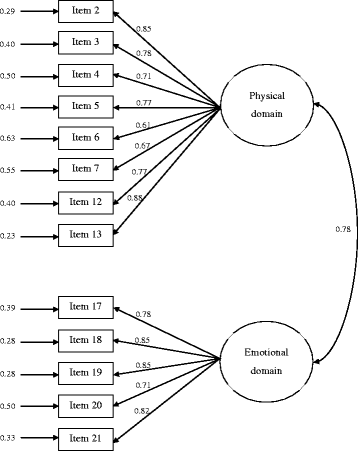The Minnesota living with heart failure questionnaire: comparison of different factor structures
- PMID: 26887590
- PMCID: PMC4756518
- DOI: 10.1186/s12955-016-0425-7
The Minnesota living with heart failure questionnaire: comparison of different factor structures
Abstract
Background: The Minnesota Living with Heart Failure Questionnaire (MLHFQ) is one of the most widely used health-related quality of life questionnaires for patients with heart failure (HF). It provides scores for two dimensions, physical and emotional, and a total score. However, there are some concerns about its factor structure and alternatives have been proposed, some including a third factor representing a social dimension. The objectives of the present study were to analyze the internal structure of the MLHFQ and the unidimensionality of the total score, and to compare the different factor structures proposed.
Methods: The MLHFQ was given to 2565 patients with HF. The structural validity of the questionnaire was assessed by confirmatory factor analysis (CFA), and Rasch analysis. These two approaches were also applied to the alternative structures proposed.
Results: The CFA results for the hypothesized model of two latent factors and the Rasch analysis confirmed the adequacy of the physical and emotional scales. Rasch analysis for the total score showed only two problematic items. The results of the CFA for other two-factor structures proposed were not better than the results for the original structure. The Rasch analyses applied to the different social factors yielded the best results for Munyombwe's social dimension, composed of six items.
Conclusions: Our results support the validity of using the MLHFQ physical, emotional and total scores in patients with HF, for clinical practice and research. In addition, they confirmed the existence of a third factor, and we recommend the use of Munyombwe's social factor.
Figures
References
-
- Swedberg K, Cleland J, Dargie H, et al. Guidelines for the diagnosis and treatment of chronic heart failure: executive summary (update 2005): The Task Force for the Diagnosis and Treatment of Chronic Heart Failure of the European Society of Cardiology. Eur Heart J. 2005;26(11):1115–40. doi: 10.1093/eurheartj/ehi204. - DOI - PubMed
Publication types
MeSH terms
LinkOut - more resources
Full Text Sources
Other Literature Sources
Medical
Research Materials
Miscellaneous


